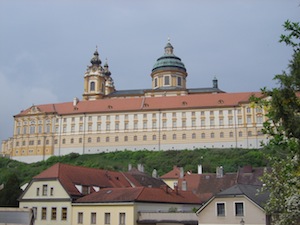Melk monastery and library

Founded by margrave Leopold II in 1089, the Benedictine monastery was mostly destroyed by a fire in 1297. However, natural catastrophes, epidemics and other drawbacks accelerated the decay of monastic life throughout Europe in these centuries. In the 15th century, the monastery of Melk was the starting point of one of the most important medieval monastic reforms, the “Melk Reform”. Under the reform abbot Nikolaus Seyringer, Melk developed into a model monastery with strict discipline and had close connections to the humanistic scholars of the University of Vienna. Two thirds of the medieval manuscripts of Melk derive from this time.
Visible evidence of the monastery’s importance in the Baroque as well as of the outstanding status of the abbot at the time, Berthold Dietmayr, is the magnificent baroque building. This was built between 1702 and 1736 following plans of Jakob Prandtauer and in cooperation with some of the most renowned artists of the time. In this period the monastery also showed flourishing activity in other fields, for example liberal arts or music.
Although the monastery was spared from the fate of dissolution during the rule of Joseph II (1780-90), numerous state regulations were imposed on monastic life. For example, imperial lay abbots were installed, the monastery’s theological school was closed upon imperial order.
The Napoleonic Wars and the end of the feudal period in 1848 brought substantial economic changes and difficulties for the monastery. In the 19th century, the first extensive restoration was carried out, and the rooms for the secondary school and boarding school were expanded. The monastery received a modern sewage system, electricity and new plumbing around 1900.
The two world wars again brought great problems to the monastery. In addition to economic difficulties in the time of inflation, there was the threat of imminent dissolution by the Nazi regime after the “Anschluss” in 1938. Fathers were threatened with arrest. The secondary school was taken away from the Benedictines and a large part of the abbey confiscated for a state secondary school. In 1945 the Benedictines resumed education in their school.
In 1989 the Abbey celebrated its 900 anniversary with a big exhibition. Next to its usual income from agriculture and forestry, the abbey now emphasizes on tourism. In the “Emperors Room” there is one of the most modern abbey exhibitions, with the permanent exhibition “On a journey from yesterday to today – Abbey of Melk”.
The library of Melk Abbey consists of a total of twelve rooms containing about 1.888 manuscripts, 750 incunabula (printed works before 1500), 1700 works from the 16th, 4500 from the 17th, and 18.000 from the 18th century; together with the newer books, approximately 100.000 volumes in total. For further information about the library, follow the links below.
Sources:
http://www.stiftmelk.at/;
http://de.wikipedia.org/wiki/Stift_Melk;
http://fabian.sub.uni-goettingen.de/?Benediktinerstift_%28Melk%29
Image source:
commons.wikimedia.org/wiki/File:Stift_Melk_dsc01546.jpg





